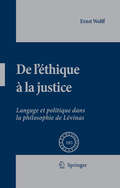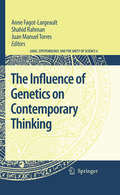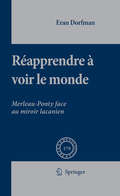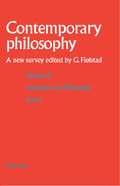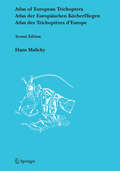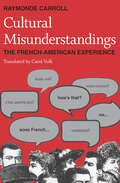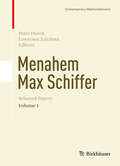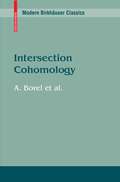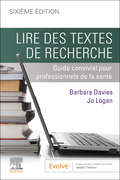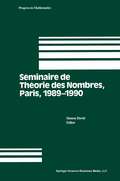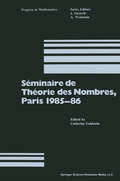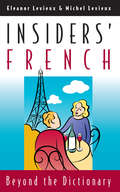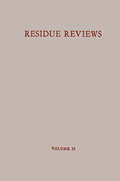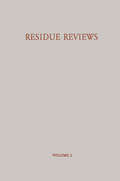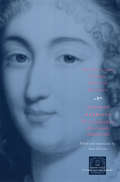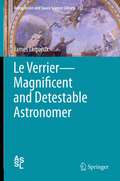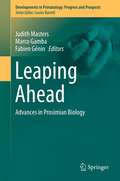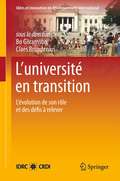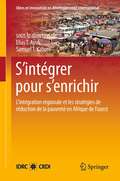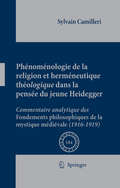- Table View
- List View
De L'éthique à la Justice: Langage et politique dans la philosophie de Lévinas (Phaenomenologica #183)
by Ernst WolffEmmanuel Lévinas est le philosophe de la non-indifférence; il n’est en aucune sorte un philosophe indifférent. Son inquiétude personnelle et engagement politique ont trouvé une expression philosophique dans une quête à deux versants. Dans le versant ontologique, il cherche à montrer que même si l’homme est l’événement de compréhension de l’être, tout l’homme et toute signification ne se réduisent pas à la compréhension de l’être seul. Dans le versant politique, il s’interroge sur la possibilité de soumettre la tendance totalitaire de toute politique à une recherche de justice qui ne dépend pas finalement de la politique même. Mais ces deux versants n’en font qu’un. La découverte d’une signification qui excède la compréhension de l’être – l’éthique – fournit en même temps la source de renouvellement de la justice. Ainsi, par cette double question, Lévinas nous présente les fils conducteurs de notre enquête: une signification au-delà de la compréhension de l’être et sa portée éthique, que nous appelons «langage» et que nous explorons dans la perspective de son importance politique. Les études analytiques dans lesquelles les notions de politique et de langage fonctionnent comme clef d’interprétation mutuelle débouchent sur une critique centrée sur deux problèmes: l’impossibilité d’interpréter la signifiance de l’autre et le danger inhérent à la conception d’une justice dépassant l’Etat.
The Influence of Genetics on Contemporary Thinking (Logic, Epistemology, and the Unity of Science #6)
by Anne Fagot-Largeault Shahid Rahman Juan Manuel TorresThis interdisciplinary volume reflects on the effects of recent discoveries in genetics on a broad range of scientific fields. It shows the way in which those discoveries influence genetics itself and many other fields, and explains the impact of genetics on contemporary culture. The volume contains the most recent views of the Nobel Laureate François Jacob on genetics and the nature of living things.
Réapprendre à voir le monde: Merleau-Ponty face au miroir lacanien (Phaenomenologica #179)
by Eran Dorfman« La vraie philosophie est de rapprendre à voir le monde, et en ce sens une histoire racontée peut signifier le monde avec autant de “p- fondeur” qu’un traité de philosophie. Nous prenons en main notre sort, nous devenons responsables de notre histoire par la réflexion, mais aussi bien par une décision où nous engageons notre vie, et dans les deux cas 1 il s’agit d’un acte violent qui se vérifie en s’exerçant .» Notre étude aura pour tâche d’élucider ce passage, écrit par Maurice Merleau-Ponty dans l’avant-propos de sa Phénoménologie de la perception. S’agit-il d’une nouvelle notion de la philosophie comme apprentissage, non seulement d’un regard théorique sur le monde, mais aussi et surtout d’un regard engagé, un regard qui est déjà dans le monde ? La philosophie pourra- elle nous apprendre comment « prendre en main notre sort », comment faire de notre histoire personnelle une histoire racontée, inventée et créée par la réflexion ? Quelle pourrait donc être cette réflexion en tant qu’acte violent ? Est-ce une philosophie qui se mêle à la vie, qui se confond avec elle tout en la rappelant, en la réapprenant, une façon oubliée de regarder qui est en même temps une façon oubliée de vivre ? Et de quelle vie s’agit-il ? Celle du philosophe même, de ses lecteurs ou de l’homme en tant que tel ? Ce sont ces questions qui vont nous occuper dans les pages qui
Volume 9: Aesthetics and Philosophy of Art (Contemporary Philosophy: A New Survey #9)
by Guttorm FløistadThis book continues the series Contemporary Philosophy (International Institute of Philosophy), which surveys significant trends in contemporary philosophy. The new volume on Aesthetics, comprising nineteen surveys, shows the variety of approaches to Aesthetics in various cultures. The close connection between aesthetics and religion and between aesthetics and ethics is emphasized in several contributions.
Atlas of European Trichoptera: Atlas der Europäischen Köcherfliegen / Atlas des Trichoptères d’Europe
by Hans MalickyCaddis flies are important indicators of environmental quality in aquatic biotopes. This Atlas is the first book which enables the identification of the entire European caddis fly fauna since McLachlan’s Revision and Synopsis of 1874-1880. Identification of European caddis flies has proved difficult as a result of the widely scattered literature, and has therefore been a matter for specialists for more than hundred years. This Second Edition of The Atlas of European Trichoptera contains over 1400 species which means an increase of 25% since the first edition of 1983. Identification of specimens is one of the most difficult tasks in Zoology. This volume presents information which will enable the reader to develop his own opinions and will also help him reach decisions concerning the accuracy of his own results. The identification of specimens is undertaken by comparing the detailed drawings of the most important characteristics of all species known in Europe, the Mediterranean countries north of the Sahara, the Canary islands, Madeira, the Azores islands and the adjacent eastern regions including the Arab Peninsula and Iran. The fauna of Turkistan and Siberia is partially included. Explanations of the drawings are provided mainly by symbols which enable the use of this book independent of language. This concept has been proved successful in University courses. The introductory chapters are in English, German and French. Should a reader not understand any of these languages, the translation of these few pages, including the pages of explanations, will provide sufficient understanding for the entire book.
Cultural Misunderstandings: The French-American Experience
by Raymonde CarrollRaymonde Carroll presents an intriguing and thoughtful analysis of the many ways French and Americans—and indeed any members of different cultures—can misinterpret each other, even when ostensibly speaking the same language. Cultural misunderstandings, Carroll points out, can arise even where we least expect them—in our closest relationships. The revealing vignettes that Carroll relates, and her perceptive comments, bring to light some fundamental differences in French and American presuppositions about love, friendship, and raising children, as well as such everyday activities as using the telephone or asking for information.
Menahem Max Schiffer: Selected Papers Volume 1 (Contemporary Mathematicians)
by Peter Duren and Lawrence ZalcmanThis two volume set presents over 50 of the most groundbreaking contributions of Menahem M Schiffer. All of the reprints of Schiffer’s works herein have extensive annotation and invited commentaries, giving new clarity and insight into the impact and legacy of Schiffer's work. A complete bibliography and brief biography make this a rounded and invaluable reference.
Intersection Cohomology (Modern Birkhäuser Classics Ser.)
by Armand BorelThis book is a publication in Swiss Seminars, a subseries of Progress in Mathematics. It is an expanded version of the notes from a seminar on intersection cohomology theory, which met at the University of Bern, Switzerland, in the spring of 1983. This volume supplies an introduction to the piecewise linear and sheaf-theoretic versions of that theory as developed by M. Goresky and R. MacPherson in Topology 19 (1980), and in Inventiones Mathematicae 72 (1983). Some familiarity with algebraic topology and sheaf theory is assumed.
Lire des textes de recherche E-Book: Guide convivial pour infirmiers et autres professionnels de la santé
by Barbara Davies Jo LoganReading Research is also available in English. Idéal à la fois pour étudiants et pour professionnels de la santé, Lire des textes de recherche: Guide convivial pour professionnels de la santé, sixième édition est une introduction pratique de niveau débutant à la recherche en sciences santé. Le texte est rédigé à l'intention de personnes n'ayant peu ou pas d'expériences dans l'analyse de publications de recherche et fournit des lignes directrices pour comprendre les articles de recherche. Il couvre aussi les éléments importants des recherches publiées, telles les méthodes de recherche, la terminologie régulière, l'analyse des données et les résultats. Tous les chapitres ont été remis à jour avec de nouveaux écrits ayant une influence sur la pratique fondée sur des savoirs probants et une synthèse des plus récentes recherches. Pour les personnes déjà dans le domaine, le livre offre une brève discussion sur la façon dont les résultats peuvent servir et être mis en pratique.Vue d’ensemble concise de la recherche reliée aux sciences santé maximise votre temps d’étude en incluant tous les types populaires de méthodologies de recherche.UNIQUE! Boîtes conseils fournissent des suggestions pratiques faciles à suivre aux personnes débutantes en la matière.UNIQUE! Boîtes alertes! avertissent des postulats communs lors de la lecture de texte de recherche.Site web d’accompagnement offre les Feuilles de Travail et d’Accompagnement du Lecteur pour recherche qualitative, quantitative, méthode mixte et révisions systématiques. NOUVEAU! Mise à jour de tous les chapitres incluant les termes clés et les explications des méthodes régulières de recherche. NOUVEAU! Contenu sur l’utilisation du web, des médias sociaux et d’éviter les revues de prédateurs. NOUVEAU! Augmentation de l’utilisation de la recherche pour améliorer les soins aux patients vous aide à comprendre l’importance de la recherche.NOUVEAU! Vue d’ensemble du chapitre d’introduction fournit une meilleure compréhension de l’agencement du livre et de la façon d’utiliser son contenu.
Seminaire de Theorie des Nombres, Paris 1989-1990 (Progress in Mathematics #102)
by D. SinnouLe travail ci-dessous developpe sur quelques points les tex:tes fondamentaux de C.L. Siegel [13[ et de K. Ramachandra [2). Remerclements C'est au Max Planck Institut de Bonn que la plus grande part des resultats (th. 2 et 3, ex:ception faite du point 3 d et th. 4 et 5) ont ete soit rectiges soit con~s. La rectaction definitive de ce travail a eu lieu ä l'Institut Fourier de Grenoble durant l'hiver 1990. Le th. 1 tel qu'il apparait ici, et le corollaire du th. 6 cf. identite (13), sont nouveaux. On trouvera une rectaction detailleedes th. 2 et 3 dans [51 et, parmi d'autres resultats, des th. 4, 5 et 6 dans [7). Que tous mes collegues et les deux equipes de secretartat recoivent ici mes remerciements les plus chaleureux. 2 1) On pose e( x) = e 1rix, x E C. Pour L un reseau complex:e, on note une base positivement olientee de L = lw + lw c'est-ä-dire teile que 1 2 On definit alors une forme modulaire .,.p> de poids 1 par 1](2)(w) ~fn (21l"i)ql/12 IJ ( - qn)2 1 { w2 n>l 1 12 q = e(W) , q 1 = e(W/12) , W = wt!w2 .
Séminaire de Théorie des Nombres, Paris 1985–86 (Progress in Mathematics #71)
by C. GoldsteinThis is the sixth annual volume of papers based on the outstanding lectures given at the Séminaire de Théorie des Nombres de Paris. The results presented in 1985-86 by an international group of mathematicians reflect the most recent work in many areas of number theory.
Insiders' French: Beyond the Dictionary
by Eleanor Levieux Michel LevieuxIf you had been living in France in the 1990s, the language you would have heard on the radio and television or seen in the newspapers would be far removed from the French language of ten or twenty years ago. The country and its language have changed tremendously in a relatively short period of time, and, as a result, English speakers with a grounding in French can still find themselves struggling to understand terms commonly encountered in contemporary French society. Luckily, Eleanor and Michel Levieux now bring us up to date with their Insiders' French, an utterly entertaining and informative guide to the language of the "new France." This "new France" is a country poised to experience the European single currency but uncertain about being part of Europe. It is hooked on fast food but ambivalent about the country where it originated. France today has record unemployment and an increasingly controversial immigrant population. Clearly, given the rapidly changing conditions and lifestyles, conventional French dictionaries alone cannot completely inform readers and visitors. Insiders' French offers a solution to the incomprehension, a unique handbook in which you'll find the language of European union, the space program, abortion and women's rights, high-tech industries, and health care, among other topics. Entries proceed by association of ideas and related terms, with extensive cross-referencing, while still being alphabetized for easy reference like a standard dictionary. Cartoons from major French journals add to your understanding and enjoyment. Insiders' French opens up the secret territory of French politics and culture that is often not understood by visitors or students, and it does so with wit and verve—qualities that remain in the French language despite its recent changes.
Residue Reviews/Rückstandsberichte (Reviews of Environmental Contamination and Toxicology #33)
by Francis A. GuntherThat residues of pesticide and other "foreign" chemicals in food stuffs are of concern to everyone everywhere is amply attested by the reception accorded previous volumes of "Residue Reviews" and by the gratifying enthusiasm, sincerity, and efforts shown by all the in dividuals from whom manuscripts have been solicited. Despite much propaganda to the contrary, there can never be any serious question that pest-control chemicals and food-additive chemicals are essential to adequate food production, manufacture, marketing, and storage, yet without continuing surveillance and intelligent control some of those that persist in our foodstuffs could at times conceivably endanger the public health. Ensuring safety-in-use of these many chemicals is a dynamic challenge, for established ones are continually being dis placed by newly developed ones more acceptable to food tech nologists, pharmacologists, toxicologists, and changing pest-control requirements in progressive food-producing economies. These matters are of genuine concern to increasing numbers of governmental agencies and legislative bodies around the world, for some of these chemicals have resulted in a few mishaps from improper use. Adequate safety-in-use evaluations of any of these chemicals per sisting into our foodstuffs are not simple matters, and they incorporate the considered judgments of many individuals highly trained in a variety of complex biologrcal, chemical, food technological, medical, pharmacological, and toxicological disciplines.
Residue Reviews / Rückstands-Berichte: Residues of Pesticides and other Foreign Chemicals in Foods and Feeds / Rückstände von Pesticiden und Anderen Fremdstoffen in Nahrungs- und Futtermitteln (Residue Reviews/rückstandsberichte Ser. #8)
by Francis A. GuntherThat residues of pesticide and other "foreign" chemicals in foodstuffs are of concern to everyone everywhere is amply attested by the reception accorded previous volumes of "Residue Reviews" and by the gratifying enthusiasm, sincerity, and efforts shown by all the individuals from whom manuscripts have been solicited. Despite much propaganda to the contrary, there can never be any serious question that pest-control chemicals and food additive chemicals are essential to adequate food production, manufacture, marketing, and storage, yet without continuing surveillance and intelligent control some of those that persist in our foodstuffs could at times conceivably endanger the public health. Ensuring safety-in-use of these many chemicals is a dynamic challenge, for established ones are continually being displaced by newly developed ones more acceptable to food technologists, pharma cologists, toxicologists, and changing pest-control requirements in progressive food-producing economies. These matters are also of genuine concern to increasing numbers of governmental agencies and legislative bodies around the world, for some of these chemicals have resulted in a few mishaps from improper use. Adequate safety-in-use evaluations of any of these chemicals persisting into our food stuffs are not simple matters, and they incorporate the considered judgments of many individuals highly trained in a variety of complex biological, chemical, food technological, medical, pharmacological, and toxicological disciplines.
Residue Reviews / Rückstands-Berichte: Residues of Pesticides and Other Foreign Chemicals in Foods and Feeds / Rückstände von Pesticiden und Anderen Fremdstoffen in Nahrungs- und Futtermitteln (Reviews of Environmental Contamination and Toxicology #2)
by Francis A. GuntherResidues of pesticides and other "foreign" chemicals in foodstuffs are of concern to everyone everywhere; they are essential to food production and manufacture, yet without surveillance and intelligent control some of those that persist could at times conceivably endanger the public health. The object of "Residue Reviews" is to provide concise, critical reviews of timely advances, philosophy, and significant areas of accomplished or needed endeavor in the total field of residues of these chemicals in foods, in feeds, and in transformed food products. These reviews are either general or specific, but properly they may lie in the domains of analytical chemistry and its methodology, biochemistry, human and animal medicine, legislation, pharmacology, physiology, regulation, and toxicology; certain affairs in the realm of food technology that are concerned specifically with pesticide and other food-additive problems are also appropriate subject matter. The justification for the preparation of any review for this book series is that it deals with some aspect of the many real problems arising from the presence of residues of foreign chemicals in foodstuffs. The scope of "Residue Reviews" is international. It encompasses those matters, in any country, which are involved in allowing pesticide and other plant-protecting chemicals to be used safely in producing, storing, and shipping crops. Added plant or animal pest-control chemicals or their metabolites that may persist into meat and other edible animal products (milk and milk products, eggs, etc.
Cultural Misunderstandings: The French-American Experience
by Raymonde CarrollRaymonde Carroll presents an intriguing and thoughtful analysis of the many ways French and Americans—and indeed any members of different cultures—can misinterpret each other, even when ostensibly speaking the same language. Cultural misunderstandings, Carroll points out, can arise even where we least expect them—in our closest relationships. The revealing vignettes that Carroll relates, and her perceptive comments, bring to light some fundamental differences in French and American presuppositions about love, friendship, and raising children, as well as such everyday activities as using the telephone or asking for information.
Against Marriage: The Correspondence of La Grande Mademoiselle (The Other Voice in Early Modern Europe)
by Anne-Marie-Louise d'Orléans, Duchesse de MontpensierIn seventeenth-century France, aristocratic women were valued by their families as commodities to be married off in exchange for money, social advantage, or military alliance. Once married, they became legally subservient to their husbands. The duchesse de Montpensier—a first cousin of Louis XIV—was one of very few exceptions, thanks to the vast wealth she inherited from her mother, who died shortly after Montpensier was born. She was also one of the few politically powerful women in France at the time to have been an accomplished writer. In the daring letters presented in this bilingual edition, Montpensier condemns the alliance system of marriage, proposing instead to found a republic that she would govern, "a corner of the world in which . . . women are their own mistresses," and where marriage and even courtship would be outlawed. Her pastoral utopia would provide medical care and vocational training for the poor, and all the homes would have libraries and studies, so that each woman would have a "room of her own" in which to write books. Joan DeJean's lively introduction and accessible translation of Montpensier's letters—four previously unpublished—allow us unprecedented access to the courageous voice of this extraordinary woman.
Le Verrier—Magnificent and Detestable Astronomer (Astrophysics and Space Science Library #397)
by James LequeuxTranslated from the original French by Bernard Sheehan; Edited and with an introduction by Dr. William Sheehan, a neuroscientist and amateur astronomer who is also a research fellow of the Lowell Observatory in Flagstaff, ArizonaLe Verrier was a superb scientist. His discovery of Neptune in 1846 made him the most famous astronomer of his time. He produced a complete theory of the motions of the planets which served as a basis for planetary ephemeris for a full century. Doing this, he discovered an anomaly in the motion of Mercury which later became the first proof of General Relativity. He also founded European meteorology. However his arrogance and bad temper created many enemies, and he was even fired from his position of Director of the Paris Observatory.
Leaping Ahead: Advances in Prosimian Biology (Developments in Primatology: Progress and Prospects)
by Russell TuttleLeaping Ahead: Advances in Prosimian Biology presents a summary of the state of prosimian biology as we move into the second decade of the 21st century. The book covers a wide range of topics, from assessments of diversity and evolutionary scenarios, through ecophysiology, cognition, behavioral and sensory ecology, to the conservation and survival prospects of this extraordinary and diverse group of mammals. The collection was inspired by an international conference in Ithala, KwaZulu-Natal, South Africa in 2007, where prosimian biologists gathered from Canada, Finland, France, Germany, India, Italy, Japan, Madagascar, South Africa, Tanzania, the United Kingdom, and the United States of America. The meeting reverberated with the passion prosimian researchers feel for their study subjects and with their deep concern for the future of prosimians in the face of ongoing habitat destruction and the burgeoning threat of bushmeat hunting. Chapters for this volume were contributed by researchers from across the globe; they attest to the diversity, vibrancy and rapid growth of prosimian biology, and to the intellectual advances that have revolutionized this field in recent years. Since its earliest beginnings, prosimian research and its resultant literature have had a strong francophone component, and researchers in many prosimian habitat countries are more comfortable reading and writing in French rather than English. French summaries of all chapters have been included. The volume is targeted at researchers, both those entering the field and established scientists, who have an interest in the biology of primates and small mammals. It is also aimed at conservation biologists seeking a deeper understanding of the faunas and conservation developments in Africa, Madagascar and Southeast Asia, and anyone who has an interest in discovering the true diversity of our order, the Primates.
L’université en transition: L’évolution de son rôle et des défis à relever (Idées et innovation en développement international)
by Bo Göransson and Claes BrundeniusLa mondialisation, l’ère de l’information et l’essor de l’économie du savoir transforment profondément les modalités d’acquisition, de diffusion et de transformation du savoir. Il s’ensuit que la production du savoir a graduellement davantage à voir avec la compétitivité économique et y est plus directement liée. Ce nouvel état de fait signifie également que les universités se sentent de plus en plus poussées à s’adapter aux besoins de la société et de l’économie, qui évoluent sans cesse. En particulier, des pressions croissantes s’exercent sur les établissements d’enseignement supérieur et de recherche des pays industrialisés pour qu’ils définissent et affirment leur nouveau rôle au sein du système national d’innovation. Les établissements des pays en développement, quant à eux, sont appelés à définir le rôle qu’ils joueront afin de soutenir les structures émergentes du système d’innovation. Ce livre examine le rôle des universités et des instituts de recherche nationaux dans le développement économique et social. En réunissant des textes rendant compte d’initiatives et d’innovations dans diverses régions du monde, notamment en Chine, en Europe de l’Est, en Amérique latine, en Scandinavie, en Asie du Sud-Est, en Afrique subsaharienne et en Europe de l’Ouest, l’ouvrage brosse un tableau qui est d’actualité et qui intéressera tant les responsables des politiques et les administrateurs d’universités que les leaders économiques et sociaux et les chercheurs. Bo Göransson et Claes Brundenius sont tous deux affiliés au Research Policy Institute de l’Université de Lund, en Suède. M. Göransson est professeur agrégé et coordonnateur du programme LEAP4D, et M. Brundenius est professeur honoraire.
S’intégrer pour s’enrichir: L’intégration régionale et les stratégies de réduction de la pauvreté en Afrique de l’ouest (Idées et innovation en développement international)
by Elias T. Ayuk and Samuel T. KaboréL’intégration régionale comme premier pas vers l’accès au marché mondial? Dans un contexte où la libéralisation du commerce n'a pas entraîné les gains escomptés par les pays sous-développés et où la croissance du commerce mondial ne s’est pas accompagnée d’une croissance économique équivalente, une solution alternative a émergée. Un nouveau paradigme a fait valoir que la libéralisation des échanges devait s’accompagner d’investissements publics. Cela dit, la nature même de la libéralisation du commerce entraîne une diminution des ressources nécessaires aux investissements publics. Sur la base d’arguments solides, les pays sous-développés sont donc actuellement encouragés à mettre d’abord l’accent sur l'intégration régionale avant de rechercher l’accès au marché mondial. Cet ouvrage, qui aborde les questions liées à l’intégration régionale en Afrique de l’ouest, présente des données empiriques sur les efforts entrepris par les pays de l'Union économique et monétaire ouest-africaine (UEMOA) pour la convergence de leurs économies. Il examine également comment ces efforts, qui représentent un élément important pour l’intégration régionale, influent sur la réduction de la pauvreté dans les pays de l’UEMOA. Il intéressera par conséquent tous les chercheurs qui travaillent sur ce thème.
Insiders' French: Beyond the Dictionary
by Eleanor Levieux Michel LevieuxIf you had been living in France in the 1990s, the language you would have heard on the radio and television or seen in the newspapers would be far removed from the French language of ten or twenty years ago. The country and its language have changed tremendously in a relatively short period of time, and, as a result, English speakers with a grounding in French can still find themselves struggling to understand terms commonly encountered in contemporary French society. Luckily, Eleanor and Michel Levieux now bring us up to date with their Insiders' French, an utterly entertaining and informative guide to the language of the "new France." This "new France" is a country poised to experience the European single currency but uncertain about being part of Europe. It is hooked on fast food but ambivalent about the country where it originated. France today has record unemployment and an increasingly controversial immigrant population. Clearly, given the rapidly changing conditions and lifestyles, conventional French dictionaries alone cannot completely inform readers and visitors. Insiders' French offers a solution to the incomprehension, a unique handbook in which you'll find the language of European union, the space program, abortion and women's rights, high-tech industries, and health care, among other topics. Entries proceed by association of ideas and related terms, with extensive cross-referencing, while still being alphabetized for easy reference like a standard dictionary. Cartoons from major French journals add to your understanding and enjoyment. Insiders' French opens up the secret territory of French politics and culture that is often not understood by visitors or students, and it does so with wit and verve—qualities that remain in the French language despite its recent changes.
Against Marriage: The Correspondence of La Grande Mademoiselle (The Other Voice in Early Modern Europe)
by Anne-Marie-Louise d'Orléans, Duchesse de MontpensierIn seventeenth-century France, aristocratic women were valued by their families as commodities to be married off in exchange for money, social advantage, or military alliance. Once married, they became legally subservient to their husbands. The duchesse de Montpensier—a first cousin of Louis XIV—was one of very few exceptions, thanks to the vast wealth she inherited from her mother, who died shortly after Montpensier was born. She was also one of the few politically powerful women in France at the time to have been an accomplished writer. In the daring letters presented in this bilingual edition, Montpensier condemns the alliance system of marriage, proposing instead to found a republic that she would govern, "a corner of the world in which . . . women are their own mistresses," and where marriage and even courtship would be outlawed. Her pastoral utopia would provide medical care and vocational training for the poor, and all the homes would have libraries and studies, so that each woman would have a "room of her own" in which to write books. Joan DeJean's lively introduction and accessible translation of Montpensier's letters—four previously unpublished—allow us unprecedented access to the courageous voice of this extraordinary woman.
Phénoménologie de la religion et herméneutique théologique dans la pensée du jeune Heidegger: Commentaire analytique des Fondements philosophiques de la mystique médiévale (1916-1919) (Phaenomenologica #184)
by Sylvain CamilleriCette étude tente de reconstruire la première phénoménologie de la religion du jeune Heidegger par l’examen du recueil de notes éparses rédigées entre 1916 et 1919 et intitulé rétrospectivement Les fondements philosophiques de la mystique médiévale. Entre sa thèse d’habilitation et ses premiers cours d’après-guerre, Heidegger se consacre à l’écriture d’une Phénoménologie de la conscience religieuse qui, pour des raisons quelque peu mystérieuses, restera finalement inachevée. Si certains de ses éléments seront repris et assimilés dans les cours sur Paul et Augustin des années 1920 et 1921, de nombreux autres, concernant des auteurs tels que Maître Eckhart, Bernard de Clairvaux, Luther, Schleiermacher ou Adolf Reinach, ou des notions phénoménologiques, théologiques et religieuses, telles que la prédonation, la foi, la prière ou l’a priori religieux, trouvent dans ce texte une thématisation tout à fait spécifique, dictée par une situation biographique et philosophique singulière. C’est pour répondre à cette dimension hapaxique que ce livre tente un commentaire exhaustif des notes heideggeriennes. Et c’est à l’occasion de cette lecture suivie que sont apparues les grandes lignes de ce que l’on peut appeler une « herméneutique théologique » censée guider la phénoménologie sur le terrain religieux nouvellement investi et la familiariser avec des phénomènes qui résistent en certains endroits à son esprit méthodique. Malgré leur caractère introductif, les premières recherches de Heidegger témoignent d’une richesse, d’une profondeur et d’un respect de la vie religieuse inégalés à ce jour et il n’est pas exagéré de dire qu’elles devraient servir de prolégomènes à toute phénoménologie future de la religion. Ainsi, parallèlement au travail d’explication, le travail ici présenté esquisse en ce domaine quelques chemins possibles en prolongeant certaines descriptions heideggeriennes et en posant les bases d’un nouveau dialogue entre phénoménologie, théologie et sciences religieuses.
Rediscovering Phenomenology: Phenomenological Essays on Mathematical Beings, Physical Reality, Perception and Consciousness (Phaenomenologica #182)
by Luciano Boi Pierre Kerszberg Édéric PatrasThis book proposes a new phenomenological analysis of the questions of perception and cognition which are of paramount importance for a better understanding of those processes which underlies the formation of knowledge and consciousness. It presents many clear arguments showing how a phenomenological perspective helps to deeply interpret most fundamental findings of current research in neurosciences and also in mathematical and physical sciences.
